Peter Paul Rubens Drawing of Body
Juggling dozens of commissions at once, Peter Paul Rubens and his staff created hundreds of dynamic drawings and oil sketches.
past John A. Parks
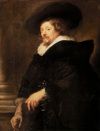 |
| Self-portrait 1638–1640, oil, 43 10 33½. Collection |
Born in 1577 and based in Antwerp, Belgium, Peter Paul Rubens towered over the art of the 17th century equally an almost superhuman force. Not just was his work a marvel of inventiveness, glowing with colour, rich in homo insight, and executed with endless verve and bravura, but his output was truly stupendous. It included scores of enormous altarpieces, umpteen lavish cycles of history paintings, and numerous portraits, hunting scenes, and landscapes—non to mention book illustrations and architectural designs, also equally a plethora of copies, reworkings, public decorations on a grand scale, and whatever else came up. Rubens was also a keen collector of art, particularly antique art, and made a considerable amount of money trading it. And if all this wasn't plenty, he was likewise a revered diplomat and man of diplomacy who negotiated much business for Espana and the Netherlands, including a pivotal function in the peace treaty between Espana and England, signed in London in 1630. Rubens also amassed a large amount of real estate, finishing his life in splendor, ensconced in a country castle, managing his lands, raising a second family unit with a new teenage bride, and painting a series of vast and grand landscapes for his own pleasure. One can feel exhausted only thinking about the man.
Add together to this the product of hundreds of drawings. Ii recent exhibitions presented a unique opportunity to come across behind the scenes of Rubens' vast production. The Bruce Museum, in Greenwich, Connecticut, hosted "Fatigued past the Brush: Oil Sketches by Peter Paul Rubens" until the end of January, when it traveled to the Berkeley Fine art Museum, in Berkeley, California, for viewing until May 15. Meanwhile, The Metropolitan Museum of Art, in New York City, mounted a major loan exhibition of the artist's drawings from Jan 15 through April three. Autonomously from the sheer abundance of visual pleasure offered, these events immune 1 to understand how Rubens went about the business of making first-class paintings on a chiliad calibration.
| THE EVOLUTION OF A RUBENS Cartoon | |
| 1. The artist made preliminary sketches in black chalk on rough paper. Sometimes he also used cerise chalk, and sometimes he tinted the sketch with a bistre launder. Rubens would often use his vast stock of copies of the Italian masters for ideas on the limerick and the figures in it. 2. Next, he fabricated a small oil sketch of the composition on a prepared wooden panel, using black chalk, painting thinly and quickly. Rubens' powers were such that he could conjure upward a sense of the much larger picture to come up with great economy and freedom. The finished sketch was presented to the client for approval and used in the studio as a guide for his assistants. iii. One time a composition was approved, Rubens would make large drawings in black chalk, using live models for the poses needed for the painting. Since female models were scarce, he frequently used male models for the female figures. This stage allowed him to incorporate increased anatomical information and a wealth of detail. 4. The finished painting would brainstorm with a black-chalk cartoon. Rubens would ofttimes have his assistants pigment the early stages of the work earlier executing the finishing touches himself. | |
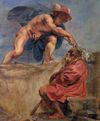 |
| The Three Graces ca. 1625–1628, oil on console, 15½ x fifteen½. Drove Dulwich Picture Gallery, London, England. |
The first thing to remember nearly both exhibitions is that Rubens himself would never have thought to present them. He would have no more exhibited his drawings than he would accept appeared in public in his underwear. Indeed, for almost all artists prior to the late 19th century, the finished product was the point of the whole business, and all else made in the studio was merely supportive and often discarded later utilize. Rubens' drawings and oil sketches played a variety of supporting roles in his work from the very beginning of his career, when he was apprenticed to Antwerp painter Adam van Noort, and afterwards to Otto van Veen. Post-obit the practise of the day, the young creative person made numerous copies of masterworks, particularly the Northern painters Tobias Stimmer and Hans Holbein. In 1600, Rubens moved to Italy, where he obtained a position with the court of the Knuckles of Gonzaga in Mantua. There, he spent an enormous amount of energy making drawings of the work of all the Renaissance masters, particularly Titian, Michelangelo, and Raphael. The purpose of this enterprise was not simply to larn; it was actually an attempt to ransack the available iconography and compositions and then that he could amass a personal library of imagery for afterward employ. What the artist about valued in these drawings was not their personal calligraphy or quality of rendering, but simply their design information. Later he left Italy in 1608 to take upward permanent residence in Antwerp, Rubens connected to use immature artists to sketch whatever paintings in Italia they might find of interest. Rubens and so valued his stockpile of imagery that in his will he stipulated that it be kept intact for whatever of his children who might wish to get painters. Sadly, none of them did.
 |
| Seated Young Adult female With Raised Artillery ca. 1631–1632, black and cherry-red chalk with white heightening, 16 x 19 11/xvi. Collection Staatliche Museen zu Berlin, Kupferstichkabinett, Berlin, Germany. |
The value of his image bank was immediately evident upon Rubens' return to Antwerp. The Counter-Reformation was in full swing and the Roman Catholic Church was intent on using revamped, powerful imagery and lavish ornamentation to lure believers away from the new pugnacious doctrines of Martin Luther, which had swept through much of Northern Europe. In the side by side eleven years Rubens would receive commissions for some 64 altarpieces—large-calibration works often involving several related panels—and many other religious pieces. In order to produce such an enormous corporeality of work, Rubens set up a studio along the lines of the Italian masters, with assistants and apprentices. Exactly how many people he employed is unknown. By securing appointment to the court of Isabella and Albert, the rulers of the Lower Netherlands, Rubens had managed to avoid the scrutiny of the Club of Painters, which commonly kept records of such things. (This freedom may have also given him a technical border in avoiding the many petty restrictions that the guild enforced.) Any the actual numbers, Rubens' drawings and oil sketches make much more sense when considered within the context of a collaborative enterprise.
Rubens approached a large work in a serial of stages. Outset, the artist would make preliminary drawings in black chalk, sometimes in combination with brown chalk. At this betoken he would often refer to his extensive library of copies, merely the work of his forebears always underwent radical transformation at his hand. Rubens had an extraordinary ability to exhale life and movement into figures and find new rhythms in erstwhile compositional ideas. Clearly, he used these preparatory drawings every bit creative adventures, and many of them bear the marks of numerous changes of pose and position as the artist's ideas evolved. He would often alter from chalk to pen-and-ink, augmenting with a light bistre (brown) wash. Sometimes, the drawing is left in a very uneven status, with some parts heavily built up while others are left more or less open, as in The Assumption of the Virgin.
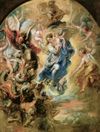 |
| The Virgin As the Woman of the Apocalypse ca. 1623–1624, oil on console, 24¾ x 19¼. Collection The J. Paul Getty Museum, Los Angeles, California. |
One time he decided on the composition, the artist executed an oil sketch. These were relatively small-scale renderings on gessoed woods panel. The artist would begin with a blackness-chalk line cartoon and and then build the paradigm broadly in layers of sparse oil paint, beginning with browns to plant the tonal construction, so laying in color. No technical description, however, can account for the almost magical way in which the artist conjured complicated scenes with such economy and freedom. Fifty-fifty in Rubens' fourth dimension, these works were much admired.
The oil sketch filled two roles in Rubens' business: Beginning and foremost, it was created for presentation to the customer for approval before proceeding to the finished piece of work. In a climate of intense competition for the souls of Europe, religious images were subjected to close scrutiny for iconographical accuracy. Rubens was a considerable scholar and fluent in Latin, attributes that he occasionally needed in arguments with his clerical clients. In one case approved, the oil sketch could then be used in the studio as a model for Rubens and his assistants.
One more stage was required, however, before work on the finished fine art could brainstorm. Rubens fabricated larger drawings in blackness chalk from live models. This allowed him to comprise a wealth of particular and anatomical accuracy. Many of these drawings are regarded every bit the creative person'southward finest because of the sure treatment and electric sense of life they showroom.
Exactly how Rubens deployed his administration on final works is not quite articulate. One company recounts that Rubens made an outline in chalk on the canvas or panel and practical one or ii patches of color, leaving his assistants to piece of work up the composition. (He was obviously fortunate to have gifted assistants, a group that for some years included Anthony van Dyck.) At the very finish of the process, Rubens himself would apply the finishing touches. Most probable, there was some flexibility in approach, and there are occasions when Rubens seems to accept washed all of the steps himself.
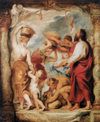 |
| The Gathering of Manna ca. 1626, oil on panel, 25? ten xx½. Collection Los |
His speed as a painter was legendary. He could finish an entire portrait in a morning, and 1 visitor describes him painting rapidly while dictating correspondence and listening to an banana reading to him in Latin. Not surprisingly, Rubens cared picayune for sleep. He rose at four in the morning, attended a short Mass, and so worked until four or five in the evening, at which time he liked to take a ride on horseback exterior the city walls before having dinner with friends.
Ruben'southward appetite for commissions, especially large work, was voracious. In 1621, in addition to his outstanding orders for altarpieces and history scenes, Rubens contracted with Marie de Médicis—the mother of the Male monarch of France—for 24 huge canvases for installation in the Luxembourg Palace. The borderline was two years, and Rubens met it in spite of endless wrangling over imagery and the usual court shenanigans. On a diplomatic mission in London in 1629, Rubens received the ceiling commission of the splendid Banqueting Hall in Whitehall. The surviving oil sketches for this project are among his best. In that location was also a commission for acres of hunting scenes for the Male monarch of France. Everyone wanted his or her work ahead of schedule and nobody wanted to pay. Rubens' claim, in 1624, that "I have become the about harassed homo in the globe" might very well have been true.
Apart from the methods described to a higher place, a number of sketches and drawings were made for other purposes. There are certain oil sketches that announced to have been worked upwards for unspecified future utilize. There are likewise several oil sketches where diverse unfinished sections suggest that the artist was using them to work out ideas. Amongst the pieces in the exhibition at The Metropolitan Museum of Art are a number of volume illustrations and some drawings for engravings. Similar most artists of his fourth dimension, Rubens had engravings made of his major compositions, which he could sell throughout Europe. Although the drawings for engravings were usually left to assistants, Rubens occasionally undertook these himself, equally in the case of The Garden of Dear. Hither, we tin can see him employing a somewhat tighter style than in his preparatory drawings, although even with this closer command the sense of liveliness and verve is unmistakable.
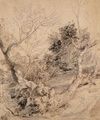 |
| Landscape With Fallen Tree ca. 1618, black chalk with white heightening and dark brownish ink on pale vitrify newspaper, 22 fifteen/16 x 19¼. Collection The Louvre, Paris, France. |
Too featured in the exhibition of drawings are a number of pieces depicting landscape details and farm life, such as Mural With Fallen Tree. These seem to have been created every bit a reference for backgrounds of larger compositions and were plain done from life. Because these drawings brandish cracking delight in exploring natural forms, it is hardly surprising that Rubens turned to landscape every bit a source of pleasance in his retirement.
Although Rubens' drawings are remarkably consistent in being focused on the business concern at hand, at that place are a few memorable occasions when the sheer pleasance of the enterprise seems to take gotten the better of him. Most notable is a drawing of peasants dancing, in which a rough country couple is drawn cavorting in various poses, full of life as they romp across the page.
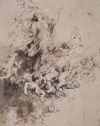 | 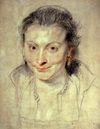 |  |
| The Assumption of the Virgin ca. 1612–1615, dark-brown ink and brown wash, white trunk colour, and black chalk on brown newspaper, 11? x 9?. Collection Albertina Museum, Vienna, Austria. | Isabella Brandt ca. 1621, black and red chalk with white heightening, brush color, cherry-red trunk color on light grey-brownish paper, 15 10 xi½. Collection The British Museum, London, England. | Head of a Negro ca. 1618–1620, oil on panel, 17¾ x 14½. The Hyde Drove, Glens Falls, New York. |
A big body of Rubens' preparatory drawings remains, but a far larger number has been lost amid the events of the world. The creative person would not have been surprised that Europe would be engulfed in war and upheaval for the next several centuries. Equally a diplomat, he believed passionately in peace and was appalled by the cavalier way in which princes subjected the population to war. He lived in a globe in which politicians cynically manipulated religious fervor to stir up trouble. "Anyone tin can first a war," he wrote, "but it is much harder to end it." Obviously he would have no trouble recognizing contemporary politics. In his painting Apologue of War, in the Palazzo Pitti in Florence, Rubens showed Mars, the god of war, stepping on a volume and also on a crumpled sketch of The Three Graces. The fact that he chose a sketch to represent the beauties trampled by war shows his smashing regard for the art of drawing—and reveals the stark connection between his work as a diplomat and his piece of work as an artist.
blackwoodmosencestiss.blogspot.com
Source: https://www.artistsnetwork.com/art-history/masters-rubens-drawings-the-marks-of-a-prolific-master/